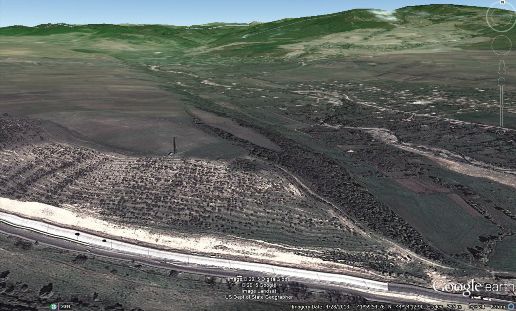
FACULTY OF HUMANITIES
FOOD AND VEGETATION IN KARTLI IN THE 5th-4th CC BC: FINDINGS ON GRAKLIANI HILL
For several years TSU scientists have been working on the Grakliani Hill--located near the villages of Igoeti, Samtavisi and Gamdlistskaro. Ten cultural layers have been discovered spanning periods from the Stone Age to Roman civilization.
Apart from studying materials created by humans during their development to provide historical interpretations, archaeology contributes to the study of specific eco-environments and the general development of natural milieu. It permits the study of earth magnetism, the evolution of flora and fauna, the palaeo-climate and other domains. Archaeology applies different technical methods according to the subject at hand, including earth remote sensing, geophysics, various chemical, physical, hydro-chemical and geochemical comparative analyses, molecular studies, and statistical-mathematical methods. This is how TSU scientists apply archaeology.
Researchers from the TSU Institute of Archaeology are studying the Grakliani Hill near the villages of Igoeti and Samtavisa, where ten cultural layers have been uncovered, including periods from the Stone Age to the Roman age. This ancient settlement and necropolis contains the inventory of local production over time. The archaeologists have excavated more than 300 graves, and have found items of clay, bronze, silver and gold, as well as items made in the centres of very different civilizations. These include seals made in the 4th-3rd Millennia BC in the ancient urban centre of Uruk in southern Mesopotamia, glass kohl-tubes (for eye makeup) and jewellery-accessories made in Achaemenid Persia and in Greece, as well as Colchian pottery.
This article provides a short description of the results of interdisciplinary investigation made by Prof. Vakhtang Licheli and Prof. Eliso Kvavadze. In 2012 the archaeologists began carrying out palynological analyses on different forms (bowls, pots, jugs, etc) found in graves, to identify specific uses for pottery, details of ancient dwellers’ everyday lives, their diet and burial rituals. (Palynology is a discipline related to botany that studies pollen grains and spores.) That year the team also began collaboration with the Institute of Palaeobotany of the National Museum. The TSU Institute of Archaeology has carried out similar palynological studies in different parts of Georgia. Interestingly, each study has resulted in new findings. Although there were not many materials obtained from the Grakliani Hill site, 32 samples taken from 25 graves offered enough micro-quantities for analysis. The palynological contents of dishes differed between samples.


■ TSU expeditions have proven that cosmetics were used as far back as the 16th century BC. Wheat, nut, sweetbrier, beech, grape and other products were buried with the deceased, while prepared meals were put in small pots.
Professor Vakhtang Licheli, Head of the TSU Institute of Archaeology headed the expeditions. He stated that the excavations yielded rich and interesting materials, especially from certain graves. Excavations revealed 200-450 palynomorphs including walnut and hornbeam dust. There were also pollen grains of oak, pine, beech, linden, oriental hornbeam and wild grape dust in small amounts. As for herbs, there were many types of plants that grew in the yards, as well as trail and rubbish areas--such as chicory, yarrow (achillea), plantain, common cocklebur, artemisia, etc. To some extent, elements of weed vegetation in wheat fields were also detected. The team found pollen grains of wheat, eryngo (eryngium), buckwheat and goosefoot (chenopodium). Pollen samples of pasture weed were rarer. Hundreds of hand mills were discovered, witnessing to the development of a wheat culture in Grakliani Hill. In 5th -4th cc BC three women could grind wheat enough for 30 kg of flour with a small mill in a storeroom. It was incredibly hard work as they ground the wheat on the bottom of the low millstone (where the wheat was loaded) by sliding the upper millstone back and forth by hand.
The researchers found a bird feather in one of the bowls, but generally poultry meat and pork were not sacrificed in the graves; instead, beef was used as an otherworldly provision. According to the religious tradition pigs were not sacrificed since they could not cross the bridge leading to the other world to reach the deceased.
Professor Eliso Kvavadze headed the palynological studies. From the dishes selected for the analysis, researchers examined the contents of 11 samples, which yielded about 200-400 palynomorphs. The results showed that preservation of pollen grains, by their concentration and composition in pots was much better than in bowls. In one grave they discovered a small pot with a different type of palynological range of contents including pollen grains from buttercups and wheat in abundance; and walnut pollen grains were also found. The palynological range in this grave also included a large amount of pollen grains of honey plants. Bee stingers were found in non-palynological residue. Accordingly, in the small pot there must have been a sweet honey dish, similar to tsandili (cooked wheat mixed with honey), made with wheat and buttercup flowers or leaves, and with walnuts. Buttercup flowers or leaves could have served as flavouring. There was a small amount of pollen in the spectra (data remains) of a jug found in another grave. Textile fibres found in the jug had more flax than cotton. According to the spectra studied, the jug must have been new and unused, and became dirty from the soil of the excavation works.
Grave number 139 contained a jug with a quantity of wood pulp cells--presumably traces of a wooden lid--as well as the pollen of honey plants such as knotweed, cornflower, buckwheat, and others. Zoological materials contained bee stingers. This, along with pollen from honey plants indicates the presence of tapluchi (an alcoholic drink flavoured with honey) in the jug. The use of a wooden cap indicates the jug had been filled with an alcoholic drink. Professors Licheli and Kvavdze stated that this important fact indicates that in the 5th – 4th BC people consumed wine as well as tapluchi. Large wine containers were found in the Grakliani Hill site. Grakliani Hill dwellers placed a jug with water in the grave for the deceased in summer and a jug with tapluchi in winter. This implies that people perceived the other world as a reality, believing the deceased would consume these drinks.
Researchers found a large amount of flax textile fibre in the sample taken from a dark-coloured stain found at the bottom of grave number 217. The stain could be disintegrated flax tissue with the residues of brown dye. Two cotton fibres were found as well, but pollen grains other than pine, were not discovered. Although pine forests are not common in these regions today, large amounts of pine dust were found in the 2500-year-old archaeological/ palynological remains. Professor Kvavadze pointed out that the different palynological spectra of dishes showed that bowls were mainly used for medicinal herbs and food. Grave number 217 was that of a woman aged 21-22, and contained silver bangles, Egyptian scarabs, an Achaemenid glass tube for kohl powder (eye makeup) and gold necklaces. According to the researchers, beauty products were used as early as the 16th c BC.
Pots were filled with provisions of wheat, walnuts, hazelnuts, rosehips, beech fruit, grapes and other food for the deceased, and some cooked food was put in smaller pots. Grave 37 is a notable example where there were provisions of walnuts in one pot and a meat dish in a smaller pot. Similarly, in grave number 148, a pot had been filled with wheat and there was a portion of sweetened wheat in a smaller pot.
According to the study of Grakliani Hill, TSU researchers conclude that local populations in the 5th- 4th cc BC used more flax for textiles and only small amounts of cotton. Wool fibres were found only in one grave, however, long-term preservation of wool fibres is always very difficult.
The researchers have not excavated enough graves to be able to determine exact seasonal mortality statistics, however according to existing data they presume that mortality rates were highest in winter—out of 25 graves, only nine persons died in summer and the others in cold periods.
Several presentations have been made on the findings of the study of the food and vegetation in 5th -4th cc BC Kartli at the Grakliani Hill site; these include Leiden University (The Netherlands) in 2013, The Museum of Natural History in Nürnberg (Germany) in March 2014, and Jena University (Germany) in July 2014.




